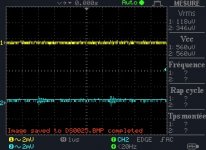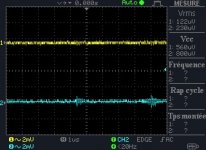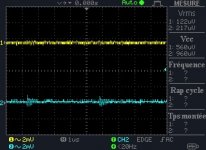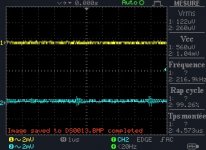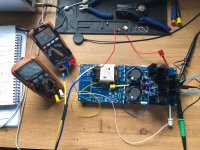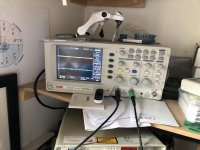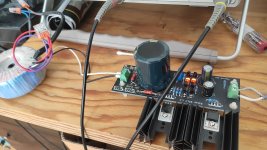Thank Salas, i will use it for a couple of DIY project
1994 Elector Preamp Class A and also for my new UGS-muse preamp (GB organized by Alex)i will use 2 shunt reg.
Yes the probe look the same ( i shut it down just for the Hard copy, i do not remember why). I have more trace....
1994 Elector Preamp Class A and also for my new UGS-muse preamp (GB organized by Alex)i will use 2 shunt reg.
Yes the probe look the same ( i shut it down just for the Hard copy, i do not remember why). I have more trace....
Attachments
Last edited:
Seeing same trace noise for probing the shunt PSU when powered on and when off its good. Means nothing significant is added to the measurement loop noise by the PSU itself at this resolution limit. For more resolution remove the probe noses and their ground wires. Put the short coil ground and probe on the Vout connector screws. That will hopefully improve your measurement loop trace noise. If there is a 20MHz bandwidth limit option in the channels menu turn it on too.
I am running 4 ultrabibs dual mono at the moment, but M2 on the + board of one side is running about 5-10c hotter than the other boards. The components are identical and the loads should be the same. I don't hear any differences between L/R but this seems strange.
It either has more spare current to burn than the other M2s or there are thermal transfer mounting to sink differences.
Both verifiable. With setting / loading measurements and mechanical inspection.
Both verifiable. With setting / loading measurements and mechanical inspection.
Are higher watt resistors noisier at R1? I'm aiming for 240-275 ccmA. There are 2.5 ohm, 5 watt, 20ppm, Vishay MRA-5s. There are plenty of 2.2 ohm lower watt resistors but higher ppm. Not sure how sensitive this location is to resistor quality.
Good question but you may not need not need high watt resistor to begin with, I used CMF60 and it only got warm at those current levels and dropping over 10V, but that was a 5V output.
True, 5W not needed in this case. Multiply 0.6V R1 drop times CCS mA to find mW. Its always about 0.6V across R1 no matter what trafo or what DC output setting because Q1 takes care of that. Then put a much larger power spec R1 to mostly get lukewarm. Say its 200mW to dissipate, put 1-2W. Thick film are noisier than thin film technology resistors.
These are all in the ballpark. Are metal film better than wirewound resistors in this position? The Yegeo looks like a good cheap option; the 2.4ohm wirewound Vishay dale looks good but I'm not sure if wirewound is less than ideal. The 3 watt 2.4 ohm Vishay is cheap, but 250ppm is higher than the others. The 1 watt 2.55 Vishay is more expensive, but looks good for that resistance value. That line also has a 3 watt 2.2ohm that I may try (CPF32R2100DKB14 Vishay / Dale | Mouser).
I'm sure all of these will work, but given some are $2-3 per resistor getting the 5 watt MRA-5 is the same price and possibly better quality (maybe not?). For example, the Reflektor build guide suggests Caddock MP930 is a nice choice for R1, but this is a very different type of resistor and maybe not applicable in the ultrabib.
FMP200JTF52-2R4 Yageo | Mouser
RS01A2R400FE12 Vishay / Dale | Mouser
PR03000202408JAC00 Vishay / BC Components | Mouser
https://www.mouser.com/ProductDetai...=sGAEpiMZZMtlubZbdhIBIFmt1EM1S6LoklB6mjo8QGw=
I'm sure all of these will work, but given some are $2-3 per resistor getting the 5 watt MRA-5 is the same price and possibly better quality (maybe not?). For example, the Reflektor build guide suggests Caddock MP930 is a nice choice for R1, but this is a very different type of resistor and maybe not applicable in the ultrabib.
FMP200JTF52-2R4 Yageo | Mouser
RS01A2R400FE12 Vishay / Dale | Mouser
PR03000202408JAC00 Vishay / BC Components | Mouser
https://www.mouser.com/ProductDetai...=sGAEpiMZZMtlubZbdhIBIFmt1EM1S6LoklB6mjo8QGw=
Last edited:
Wirewound is no problem if Ayrton-Perry wound i.e. non inductive. Dale CMF series is known for low self noise. CPF series is also proven in our regs. Yageo are stable good VFM products. KOA Speer MF series is also liked by some. MP930 was a favorite of many in the SSLV1.1 mainly but there the Rset dissipation was much higher.
Hi Salas,
Generally for the R1 position would you say that a 50ppm resistor is better than a 100ppm one?
For example, I need a 1.6-1.7r resistor. There is a Vishay RS 1.62r 3W at 50ppm or I could parallel two 100ppm 1W CMF's of double value. Whats the better choice here considering that the RS is a regular wirewound and not a non inductive type yet has the lower ppm?
Thanks. nash
Generally for the R1 position would you say that a 50ppm resistor is better than a 100ppm one?
For example, I need a 1.6-1.7r resistor. There is a Vishay RS 1.62r 3W at 50ppm or I could parallel two 100ppm 1W CMF's of double value. Whats the better choice here considering that the RS is a regular wirewound and not a non inductive type yet has the lower ppm?
Thanks. nash
Thanks for the read Hicoco. Dont know the relevance of Johnson noise in this situation where Hz is low. Generally lower ppm resistors exhibit lower noise but at higher hz as I understand it.
Since Salas has specifically mentioned the inductance issue I just wanted to better understand the trade offs between that and ppm so that I can make a wiser choice building my UltraBib's for my DCG3.
nash
Since Salas has specifically mentioned the inductance issue I just wanted to better understand the trade offs between that and ppm so that I can make a wiser choice building my UltraBib's for my DCG3.
nash
Low inductance, good ppm, good noise, are the factors that make a great resistor. Specifically inductance can bring resonance effects in high impedance nodes where some capacitance is also present. Like when in grid stopper or gate stopper roles.
R1 is not a deal breaker position if the part is average, but in previous SSLV versions enough users claimed that a good resistor had positive subjective effects there.
R1 is not a deal breaker position if the part is average, but in previous SSLV versions enough users claimed that a good resistor had positive subjective effects there.
I use there wirewound ones: Mills MRA5 or Ohmite (5W, 50ppm, 5%).
AG5J1R2E OHMITE - Ellenallas: huzalellenallas | keramia; 1,2Ω; 5W; +-5%; 50ppm/degC; AG5-1.2R-5% | TME Hungary Kft. - Elektronikai alkatreszek
AG5J1R2E OHMITE - Ellenallas: huzalellenallas | keramia; 1,2Ω; 5W; +-5%; 50ppm/degC; AG5-1.2R-5% | TME Hungary Kft. - Elektronikai alkatreszek
I am process of building a USB transport and later on a DAC. But before that I am gathering all the data possible to select best of the best for my build.
I will be highly obliged if someone can share some experience to answer my following questions.
1. Are Salas UltraBIBs the best regs around when it come to performance during listening tests.
2. How do they compare with Battery and Ultra caps solution (As IAN's battery power supply solution).
3. Can I get regulator to come down to 3.3V, 1.7V etc as required by modern DAC chips
4. How much current they can supply.
5. How do these regs compare with other ultra linear power supply solutions generally available for RPis etc.
I will be highly obliged if someone can share some experience to answer my following questions.
1. Are Salas UltraBIBs the best regs around when it come to performance during listening tests.
2. How do they compare with Battery and Ultra caps solution (As IAN's battery power supply solution).
3. Can I get regulator to come down to 3.3V, 1.7V etc as required by modern DAC chips
4. How much current they can supply.
5. How do these regs compare with other ultra linear power supply solutions generally available for RPis etc.
I have finished my first BIB build this weekend. It was a nice experience to populate a well made PCB after all the veroboard prototyping i have done lately.
I did the simple outpout resistance measurement that was proposed somewhere here. I wired everything up using a 2x9VAC 50VA toroid and it worked great from the first start. Adjusted output voltage to about 22.5 volts. My BIB runs at 200 mA setting (R1 3R) and my load, an older version of the simplistic riaa, draws exactly 50mA. In this setting my sink for M2 gets well hot, but i can still touch it (for a short while haha). I will rise R1 to 3R6 to drop the CC to 166 mA in order to get cooler temperature on M2s heatsink.
I tried to measure ripple on dc output with my oscilloscope but the only thing i could see was a flat line @ 5mV (with x1 and x10 probe).
After my first listening with the phono preamp powered by the BIB 1.3 I was really stunned. I did not expect the amount of change just because of a different PSU. Before i had used an LM317 followed by a simple capacitance multiplier that Salas gave me once. I did not have problems with noise, but compared to now the sound was more flat and compressed.
The amount and quality of stage and 3D sound is really a new experience for me as a „young“ vinyl record lover. Thanks to Salas and Tea-Bag for improving my listening experience
I did the simple outpout resistance measurement that was proposed somewhere here. I wired everything up using a 2x9VAC 50VA toroid and it worked great from the first start. Adjusted output voltage to about 22.5 volts. My BIB runs at 200 mA setting (R1 3R) and my load, an older version of the simplistic riaa, draws exactly 50mA. In this setting my sink for M2 gets well hot, but i can still touch it (for a short while haha). I will rise R1 to 3R6 to drop the CC to 166 mA in order to get cooler temperature on M2s heatsink.
I tried to measure ripple on dc output with my oscilloscope but the only thing i could see was a flat line @ 5mV (with x1 and x10 probe).
After my first listening with the phono preamp powered by the BIB 1.3 I was really stunned. I did not expect the amount of change just because of a different PSU. Before i had used an LM317 followed by a simple capacitance multiplier that Salas gave me once. I did not have problems with noise, but compared to now the sound was more flat and compressed.
The amount and quality of stage and 3D sound is really a new experience for me as a „young“ vinyl record lover. Thanks to Salas and Tea-Bag for improving my listening experience
Attachments
Congratulations and enjoy records  How much DC input your transformer achieved? Can be measured between the pins of the large capacitor.
How much DC input your transformer achieved? Can be measured between the pins of the large capacitor.
 How much DC input your transformer achieved? Can be measured between the pins of the large capacitor.
How much DC input your transformer achieved? Can be measured between the pins of the large capacitor.Hi guys, I'm planning to build a Soekris dam1021 based dac. Then, I'm considering to use this shunt regulator to feed it. As its voltage need is +-12v, what's the value of R1 I should consider? And what are the right transformer characteristics?
Thank you very much, Gaetano.
Thank you very much, Gaetano.
- Home
- Amplifiers
- Power Supplies
- Salas SSLV1.3 UltraBiB shunt regulator
